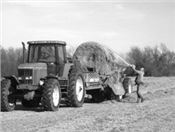|
Low Forage Protein Portends Higher Supplemental Feed Costs For Ranchers This Winter

Tom Ritz works to unwrap a round bale in preparation for rebaling into squares at his
farm near Gentry, Ark.
U of Arkansas System Division of Agriculture photo by Robert Seay
FAYETTEVILLE, ARK.
The intermittent rains that have saturated Arkansas for most of the past year have taken their toll on forage quality, confirming the suspicions of producers and forage quality researchers alike.
Shane Gadberry, professor of ruminant nutrition for the University of Arkansas System Division of Agriculture, said the rains affected every aspect of raising forage, from planting and fertilization to pest management.
“Putting up good quality hay was challenging for Arkansas ranchers in 2019,” Gadberry said. “Rain and water-logged soils kept ranchers from getting fertilizer out, weeds sprayed, and hay harvested in a timely manner. We’re starting to see the consequences in the lab.”
Between May 1 and August 27, 92 cool-season grass hay samples and 368 warm-season grass hay samples were analyzed through the Division of Agriculture’s Diagnostics Laboratory in Fayetteville. Testing results show protein averaging 9 percent in cool-season grasses and 9.8 percent in warm season grasses, with total digestible nutrients (commonly referred to as TDN) averaging 51 percent in-cool season grasses and 56 percent in warm-season grasses.
“We typically see protein above 10 percent and TDN around 54 percent in fescue, our most commonly harvested cool-season grass,” Gadberry said. “Bermudagrass is the predominate warm-season grass harvested for hay, and historically we’ve seen the protein around 12 percent and TDN close to 58 percent.”
A drop of 2 to 4 percentage points in overall quality means cows will need more supplementation through the winter. About 50 percent of available hay is testing too low in protein and energy for non-lactating cows in late gestation, Gadberry said. About 80 percent of the hay is too low in protein and energy for early-lactation cows.
“It’s uncommon to see this many hay samples not meeting the nutrient requirements of non-lactating cows,” Gadberry said.
In the short term, the extra body fat many cows are carrying from this summer’s abundant pasture growth will help them endure the winter. But if they lose too much body conditioning before calving, or are in a negative energy balance during breeding, next year’s calf crop will suffer, Gadberry said.
“The current excess supply of pasture forage is going to start dropping in quality as we move into fall,” he said. “Ranchers should visit with their county Extension agents about testing pasture forages for protein and TDN, like they would hay. If pastures test below 8 percent protein, supplemental protein may help the cows better digest those carryover grasses.”
Supplemental feed costs are likely going to be higher this winter, Gadberry said.
“The best approach to choosing the right type and amount of supplement is testing on-farm hay stocks,” he said. “Hay quality is too variable, from farm to farm and cutting to cutting, to make assumptions about supplemental feeding. A routine hay analysis will cost $18 a sample.” ∆
|
|